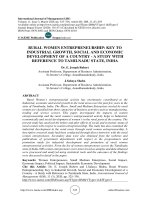Economic growth and economic development 358
Bạn đang xem bản rút gọn của tài liệu. Xem và tải ngay bản đầy đủ của tài liệu tại đây (118.72 KB, 1 trang )
Introduction to Modern Economic Growth
Therefore, the equivalent of the standard finite-horizon transversality conditions do
not hold. It can be verified, however, that along the optimal path we have
lim H (k (t) , c (t) , λ (t)) = 0.
t→∞
We will next see that this is indeed the relevant transversality condition.
Theorem 7.13. Suppose that problem of maximizing (7.28) subject to (7.29) and
(7.30), with f and g continuously differentiable, has an interior piecewise continuous
solution yˆ (t) with corresponding path of state variable xˆ (t). Suppose moreover that
limt→∞ V (t, xˆ (t)) exists (where V (t, x (t)) is defined in (7.33)). Let H (t, x, y, λ) be
given by (7.12). Then the optimal control yˆ (t) and the corresponding path of the state
variable xˆ (t) satisfy the necessary conditions (7.34)-(7.36) and the transversality
condition
(7.44)
lim H (t, xˆ (t) , yˆ (t) , λ (t)) = 0.
t→∞
Proof. Let us focus on points where V (t, x) is differentiable in t and x so that
the Hamilton-Jacobi-Bellman equation, (7.37) holds. Noting that ∂V (t, xˆ (t)) /∂x =
λ (t), this equation can be written as
∂V (t, xˆ (t))
+ f (t, xˆ (t) , yˆ (t)) + λ (t) g (t, xˆ (t) , yˆ (t)) = 0 for all t
∂t
∂V (t, xˆ (t))
(7.45)
+ H (t, xˆ (t) , yˆ (t) , λ (t)) = 0 for all t.
∂t
Now take the limit as t → ∞. Since limt→∞ V (t, xˆ (t)) exists, we have that ei-
ther limt→∞ ∂V (t, xˆ (t)) /∂t > 0 everywhere, so that limt→∞ V (t, xˆ (t)) = +∞,
or limt→∞ ∂V (t, xˆ (t)) /∂t < 0 everywhere, so that limt→∞ V (t, xˆ (t)) = −∞ or
limt→∞ ∂V (t, xˆ (t)) /∂t = 0. The first two possibilities are ruled out by the hypoth-
esis that an optimal solution that reaches the maximum exists. Thus we must have
limt→∞ ∂V (t, xˆ (t)) /t = 0. (7.45) then implies (7.44).
Ô
The transversality condition (7.44) is not particularly convenient to work with.
In the next section, we will see that as we consider discounted infinite-horizon problems stronger and more useful versions of this transversality condition can be developed.
344









